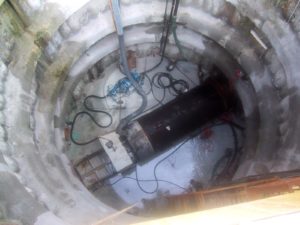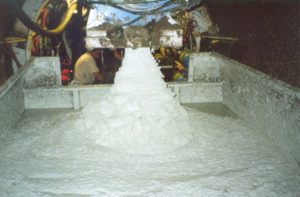![65 Years of Innovation and Experience [default]](https://www.robbinstbm.com/wp-content/uploads/2017/04/Side-Bar-Blue-Blocks_70-Years.jpg)
A Solution for Every Condition: Search our Project Database
Project Map
FEATURED PRODUCT: CROSSOVER MACHINES
Our History
A Legacy of Innovation
Information 24/7
News & Media
Insights in the Industry:
Read the Robbins Blog
 The South Central Hillsborough Intertie tunnel passes under the Alafia River in Tampa Bay. The tunnel is part of Master Water Plan Stage B, an ambitious three-stage plan to replenish Florida’s depleted groundwater.
The South Central Hillsborough Intertie tunnel passes under the Alafia River in Tampa Bay. The tunnel is part of Master Water Plan Stage B, an ambitious three-stage plan to replenish Florida’s depleted groundwater.
Tampa Bay Water, the project owner, awarded Contract 2 for the South Central Intertie to Kenko Inc. in 2002. The contractor chose an innovative new solution to deal with the difficult ground conditions of the tunnel: a Robbins hybrid EPB shield machine.
The tunnel travels though the extremely permeable, highly fractured limestone of the Floridian aquifer with over 2.5 bar of hydraulic face pressure. Above the limestone is a layer of very stiff green clay and above the clay is a 4.6 m (15 ft) thick layer of loose, silty fine sand.
The contractor chose Robbins because they needed design parameters that encompassed hard rock TBMs, EPBMs, and slurry shields. The EPBM featured eight double and four single backloading 17 inch (432 mm) cutters. The machine was capable of 5,783 kN (1,300,000 lb) of thrust and could generate a torque of 409,457 N-m (302,000 lb-ft) at the cutterhead.
Two face ports at each side of the machine permitted drilling and grouting in difficult conditions. Excavated ground was extracted with a 17 inch (432 mm) diameter invert auger screw. The muck was then conveyed to a mixing chamber to agitate and crush the limestone. The entire excavation system was a closed and pressurized face built to withstand up to 3 bar of hydraulic pressure.
From the mixing chamber, the muck traveled to a slurry pump installed inside the tunnel. The slurry pump transported the muck in a tube to the shaft where it connected with a second pump that brought the muck to the top of the shaft. The slurry pumps directly discharged the cuttings to the surface because the limestone was too porous to form a matrix. Therefore, the sluggish characteristics of the muck made muck transport via screw auger into muck cars too difficult.
 The hybrid EPBM began boring on May 27, 2002. In the early stages of tunnel excavation, the machine operated in usual EPB mode and material was removed with muck cars.
The hybrid EPBM began boring on May 27, 2002. In the early stages of tunnel excavation, the machine operated in usual EPB mode and material was removed with muck cars.
As the machine continued boring, it encountered increasing hydraulic loads of up to 2.5 bar. This anticipated condition was treated with a circular break system that kept the EPBM in place.
However, the high water pressures prevented the excavated material from forming a plug in the screw conveyor. Injection of ground conditioning additives did not improve the situation and water inflow to the tunnel continued. The mucking system was then converted from muck cars to the more efficient slurry system involving slurry pumps.
After the conversion, the EPBM progressed well and broke through on August 22, 2002 only 3 mm (1/8 in) off of target.

 Close
Close